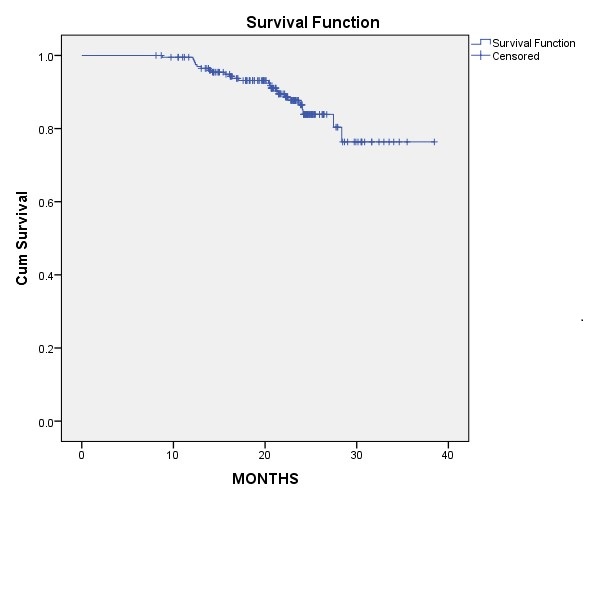real world experience with extreme hypofractionated breast RT in a tertiary care center in India
PO-1287
Abstract
real world experience with extreme hypofractionated breast RT in a tertiary care center in India
Authors: LINCOLN PUJARI1, Prashanth G1, Abhishek Shinghal2, Ashutosh Mukherji3, Satyajit Pradhan3
1HBCH & MPMMCC, RADIATION ONCOLOGY, VARANASI, India; 2HBCH & MPMMCC, Radiation Oncology , Varanasi, India; 3HBCH & MPMMCC, Radiation Oncology, Varanasi, India
Show Affiliations
Hide Affiliations
Purpose or Objective
To study the real world outcome of extremely hypo fractionationated radiotherapy in breast cancer
Material and Methods
This is a retrospective analysis of invasive duct carcinoma of breast patients who received adjuvant breast radiotherapy with extreme hypo fractionation (Dose 26Gy/5#s +/- Tumor bed boost) in a tertiary care institute in India from March 2020 to Dec 2021. The demographic details, disease characteristics, treatment parameters and disease free survival data (from date of diagnosis) were collected and analyzed by SPSS V21.
Results
Median age at presentation is 48 Years and Median follow up period in the study is 23 months in total 205 patients. (170/205) 82.9% of patient were younger than 60 years with commonest presentation being the 5th decade of life at 35.1%. 59% patients were having right sided breast tumors. 84.4 % (172/205) patients were having Grade III tumors. (130/205) 63.4% patients were T3 or T4 tumors. 77.5% (159/205) patients had node positive disease. 155 patients (75.6%) received Neo-adjuvant chemotherapy (NACT) and among them 22 patients (14.2%) had pathological complete response. 171/205 (83.4%) patients underwent modified radical mastectomy. 91.7% (188/205) patients received Nodal irradiation. 16 patients also received Axillary radiotherapy and IMN was not included for treatment. 34 patients who had breast conservation surgery, all received tumor bed boost. 32 of 34 patients had sequential electron boost to a dose of 12.5Gy in 5#s over a week and 2 patients had simultaneous integrated photon boost up to 31Gy in 5#s to tumor bed along with 26Gy/5#s to whole breast. Only 5 patients (2.4%) each developed Grade 2 and Grade 3 acute skin toxicity which was managed conservatively. Only 6 (2.9%) patients had grade 2 and only 2 patients (1%) had grade 3 odynophagia. Total of 25 patients (12.2%) had disease recurrence (distant or local) in the study period. After a median follow up of 23 months the disease free survival was 87.8%.
| PARAMETERS | No. of Patients | percentage |
| Grade |
|
|
| 1 | 3 | 1.5 |
| 2 | 29 | 14.1 |
| 3 | 173 | 84.4 |
| Stage |
|
|
| IA | 4 | 2.0 |
| IIA | 22 | 10.7 |
| IIB | 56 | 27.3 |
| IIIA | 69 | 33.7 |
| IIIB | 47 | 22.9 |
| IIIC | 7 | 3.4 |
| HORMONE POSITIVE |
|
|
| No | 73 | 35.6 |
| yes | 132 | 64.4 |
| TNBC |
|
|
| No | 157 | 76.6 |
| yes | 48 | 23.4 |
| NACT |
|
|
| No | 50 | 24.4 |
| yes | 155 | 75.6 |
| Surgery |
|
|
| BCS | 34 | 16.6 |
| MRM | 171 | 83.4 |
| Radiotherapy Site |
|
|
| Breast Only | 13 | 6.3 |
| Breast + SCF | 21 | 10.2 |
| chest wall (CW) | 4 | 2.0 |
| CW + SCF | 151 | 73.7 |
| CW+SCF+Axilla | 16 | 7.8 |
| Radiotherapy dose |
|
|
| 26Gy/5#s | 171 | 83.4 |
| 26Gy/5#s + 12.5Gy/5#s | 32 | 15.6 |
| 26Gy/5#s & 31Gy/5#s | 2 | 1.0 |
| Acute Skin Toxicity (RTOG) |
|
|
| 0 | 33 | 16.1 |
| 1 | 162 | 79.0 |
| 2 | 5 | 2.4 |
| 3 | 5 | 2.4 |
| Acute Odynphagia (RTOG) |
|
|
| 0 | 53 | 25.9 |
| 1 | 144 | 70.2 |
| 2 | 6 | 2.9 |
| 3 | 2 | 1.0 |
| Treatment Failure |
|
|
| No | 180 | 87.8 |
| Yes | 25 | 12.2 |

Conclusion
Extreme hypo-fractionation is safe and feasible option even with locally advanced breast cancer but long term follow up and well-designed randomized trials are warranted to establish it in the locally advanced breast cancer.